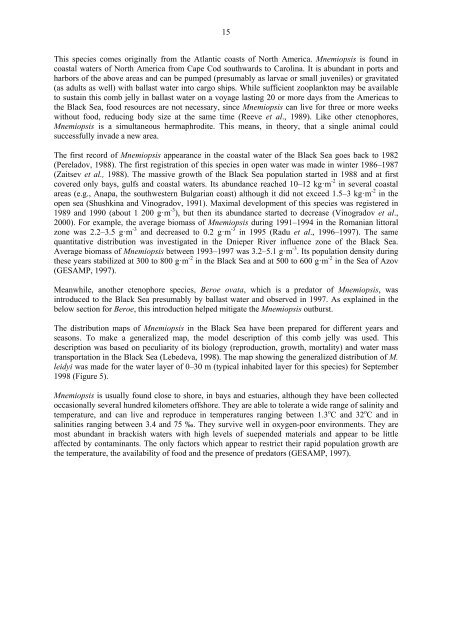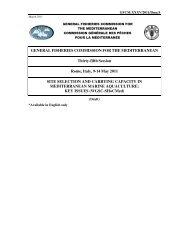Status of alien species in the Mediterranean and Black Sea
Status of alien species in the Mediterranean and Black Sea
Status of alien species in the Mediterranean and Black Sea
Create successful ePaper yourself
Turn your PDF publications into a flip-book with our unique Google optimized e-Paper software.
15<br />
This <strong>species</strong> comes orig<strong>in</strong>ally from <strong>the</strong> Atlantic coasts <strong>of</strong> North America. Mnemiopsis is found <strong>in</strong><br />
coastal waters <strong>of</strong> North America from Cape Cod southwards to Carol<strong>in</strong>a. It is abundant <strong>in</strong> ports <strong>and</strong><br />
harbors <strong>of</strong> <strong>the</strong> above areas <strong>and</strong> can be pumped (presumably as larvae or small juveniles) or gravitated<br />
(as adults as well) with ballast water <strong>in</strong>to cargo ships. While sufficient zooplankton may be available<br />
to susta<strong>in</strong> this comb jelly <strong>in</strong> ballast water on a voyage last<strong>in</strong>g 20 or more days from <strong>the</strong> Americas to<br />
<strong>the</strong> <strong>Black</strong> <strong>Sea</strong>, food resources are not necessary, s<strong>in</strong>ce Mnemiopsis can live for three or more weeks<br />
without food, reduc<strong>in</strong>g body size at <strong>the</strong> same time (Reeve et al., 1989). Like o<strong>the</strong>r ctenophores,<br />
Mnemiopsis is a simultaneous hermaphrodite. This means, <strong>in</strong> <strong>the</strong>ory, that a s<strong>in</strong>gle animal could<br />
successfully <strong>in</strong>vade a new area.<br />
The first record <strong>of</strong> Mnemiopsis appearance <strong>in</strong> <strong>the</strong> coastal water <strong>of</strong> <strong>the</strong> <strong>Black</strong> <strong>Sea</strong> goes back to 1982<br />
(Pereladov, 1988). The first registration <strong>of</strong> this <strong>species</strong> <strong>in</strong> open water was made <strong>in</strong> w<strong>in</strong>ter 1986–1987<br />
(Zaitsev et al., 1988). The massive growth <strong>of</strong> <strong>the</strong> <strong>Black</strong> <strong>Sea</strong> population started <strong>in</strong> 1988 <strong>and</strong> at first<br />
covered only bays, gulfs <strong>and</strong> coastal waters. Its abundance reached 10–12 kg·m -2 <strong>in</strong> several coastal<br />
areas (e.g., Anapa, <strong>the</strong> southwestern Bulgarian coast) although it did not exceed 1.5–3 kg·m -2 <strong>in</strong> <strong>the</strong><br />
open sea (Shushk<strong>in</strong>a <strong>and</strong> V<strong>in</strong>ogradov, 1991). Maximal development <strong>of</strong> this <strong>species</strong> was registered <strong>in</strong><br />
1989 <strong>and</strong> 1990 (about 1 200 g·m -3 ), but <strong>the</strong>n its abundance started to decrease (V<strong>in</strong>ogradov et al.,<br />
2000). For example, <strong>the</strong> average biomass <strong>of</strong> Mnemiopsis dur<strong>in</strong>g 1991–1994 <strong>in</strong> <strong>the</strong> Romanian littoral<br />
zone was 2.2–3.5 g·m -3 <strong>and</strong> decreased to 0.2 g·m -3 <strong>in</strong> 1995 (Radu et al., 1996–1997). The same<br />
quantitative distribution was <strong>in</strong>vestigated <strong>in</strong> <strong>the</strong> Dnieper River <strong>in</strong>fluence zone <strong>of</strong> <strong>the</strong> <strong>Black</strong> <strong>Sea</strong>.<br />
Average biomass <strong>of</strong> Mnemiopsis between 1993–1997 was 3.2–5.1 g·m -3 . Its population density dur<strong>in</strong>g<br />
<strong>the</strong>se years stabilized at 300 to 800 g·m -2 <strong>in</strong> <strong>the</strong> <strong>Black</strong> <strong>Sea</strong> <strong>and</strong> at 500 to 600 g·m -2 <strong>in</strong> <strong>the</strong> <strong>Sea</strong> <strong>of</strong> Azov<br />
(GESAMP, 1997).<br />
Meanwhile, ano<strong>the</strong>r ctenophore <strong>species</strong>, Beroe ovata, which is a predator <strong>of</strong> Mnemiopsis, was<br />
<strong>in</strong>troduced to <strong>the</strong> <strong>Black</strong> <strong>Sea</strong> presumably by ballast water <strong>and</strong> observed <strong>in</strong> 1997. As expla<strong>in</strong>ed <strong>in</strong> <strong>the</strong><br />
below section for Beroe, this <strong>in</strong>troduction helped mitigate <strong>the</strong> Mnemiopsis outburst.<br />
The distribution maps <strong>of</strong> Mnemiopsis <strong>in</strong> <strong>the</strong> <strong>Black</strong> <strong>Sea</strong> have been prepared for different years <strong>and</strong><br />
seasons. To make a generalized map, <strong>the</strong> model description <strong>of</strong> this comb jelly was used. This<br />
description was based on peculiarity <strong>of</strong> its biology (reproduction, growth, mortality) <strong>and</strong> water mass<br />
transportation <strong>in</strong> <strong>the</strong> <strong>Black</strong> <strong>Sea</strong> (Lebedeva, 1998). The map show<strong>in</strong>g <strong>the</strong> generalized distribution <strong>of</strong> M.<br />
leidyi was made for <strong>the</strong> water layer <strong>of</strong> 0–30 m (typical <strong>in</strong>habited layer for this <strong>species</strong>) for September<br />
1998 (Figure 5).<br />
Mnemiopsis is usually found close to shore, <strong>in</strong> bays <strong>and</strong> estuaries, although <strong>the</strong>y have been collected<br />
occasionally several hundred kilometers <strong>of</strong>fshore. They are able to tolerate a wide range <strong>of</strong> sal<strong>in</strong>ity <strong>and</strong><br />
temperature, <strong>and</strong> can live <strong>and</strong> reproduce <strong>in</strong> temperatures rang<strong>in</strong>g between 1.3 o C <strong>and</strong> 32 o C <strong>and</strong> <strong>in</strong><br />
sal<strong>in</strong>ities rang<strong>in</strong>g between 3.4 <strong>and</strong> 75 ‰. They survive well <strong>in</strong> oxygen-poor environments. They are<br />
most abundant <strong>in</strong> brackish waters with high levels <strong>of</strong> suepended materials <strong>and</strong> appear to be little<br />
affected by contam<strong>in</strong>ants. The only factors which appear to restrict <strong>the</strong>ir rapid population growth are<br />
<strong>the</strong> temperature, <strong>the</strong> availability <strong>of</strong> food <strong>and</strong> <strong>the</strong> presence <strong>of</strong> predators (GESAMP, 1997).
















